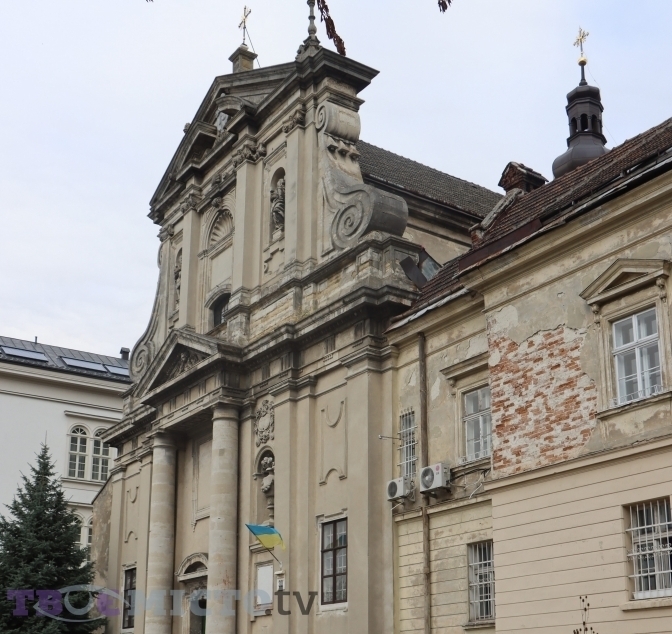
photo by Tvoe Misto
The pompous facade with magnificent baroque decoration and sculptures on Vynnychenka Street, 30a is known to almost every Lviv resident. This is the Church of the Presentation with the former Monastery of the Barefoot Carmelites. However, few people know about the problem that has arisen around the monastery complex, which is adjacent to the church.
The Barefoot Carmelite Monastery and the Roman Catholic Theological Seminary used to be located here. After the 1940s – Medical Institute and Military Administration, Regional Department of Metrology. Now, Rosen Chapel has been transferred to the ownership of the Roman Catholic Church, around the ruins of the state enterprise «Systema» (System) – a research scientific institute of metrology.
Read also: Heaven on earth. Where to see ‘secret’ frescoes in Lviv
The Baroque church can be seen on the right side of the way from the city centre to the High Castle. It is quite difficult to pass by and not pay attention to it. This is an architectural monument of the XVII century. It was built by Italian architects who were inspired by Roman churches.
It is built of ocher hewn stone. Its facade is, without exaggeration, a model of Western Baroque architecture. It consists of two columns at the entrance, decorative vases in niches, sculptures of St. Joseph and St. Libra, torn baroque pediment. This is the Church of the Presentation with the former Monastery of the Barefoot Carmelites. It once belonged to the Roman Catholic Church. Now, it has trees growing on the roof.
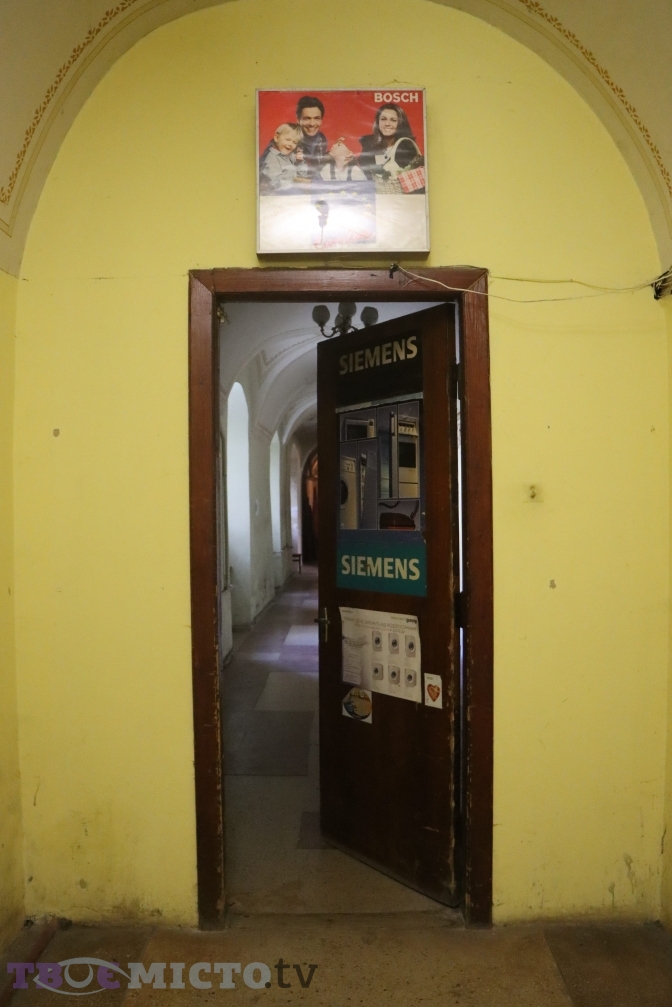
I enter the door that led to the monastery. Now they are not closed. Not because there are many tourists, but because there are no castles, no security guards, no cameras. I enter a long corridor with old vaulted ceilings. The magic of the townhouse quickly dissipates, because dampness and mustiness blow on me, I have to walk down a cold corridor without light and with torn lampshades. The walls are covered with paint, mold and murals by some schoolchildren, who look like prehistoric paintings in the Altamira Cave. The walls themselves have holes.

The corridor is branching. On the left – armored doors, behind which is «heaven on Earth,» the Rosen Chapel, which is cared for by the Roman Catholic Dominican Order, about which Lviv Now has already written. Directly is the road to the state enterprise «Systema», 30% of the premises of which have only recently been transferred to the Roman Catholic Church. 70% continue to be state-owned. Here I am greeted by abandoned kiosks (trade booths) with lowered shutters, broken windows and various, destroyed by time and people, Soviet furniture and other junk lying right in the hallway.
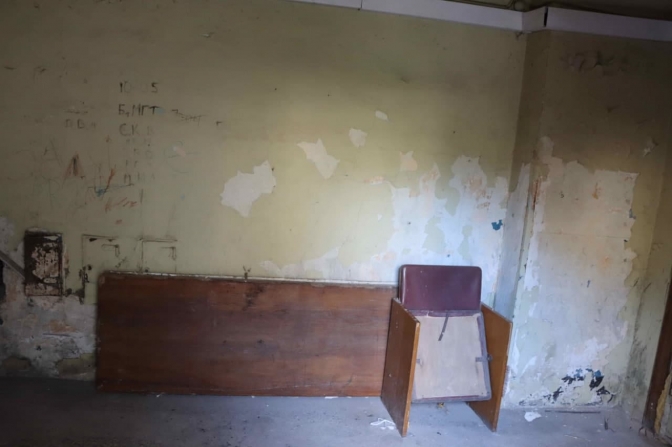
From the other entrance, there is only an arch, through which anyone can pass. There are some bags of junk lying in the open nearby, as well as huge rusty barrels. You can see that many windows in the former monastery are broken.
I go back and go through the armored door to the monastery of the Dominican Order. The stone gallery is warm, lighted and clean. A large thermos stands on a table covered with a white tablecloth, where the Dominican Fathers hold pastoral meetings almost daily. I am met by Father Dr. Ihor Hnius of the Dominican Order OP, rector of Rosen Chapel. I ask about the contrasting difference that cuts the eye and brings into dissonance.
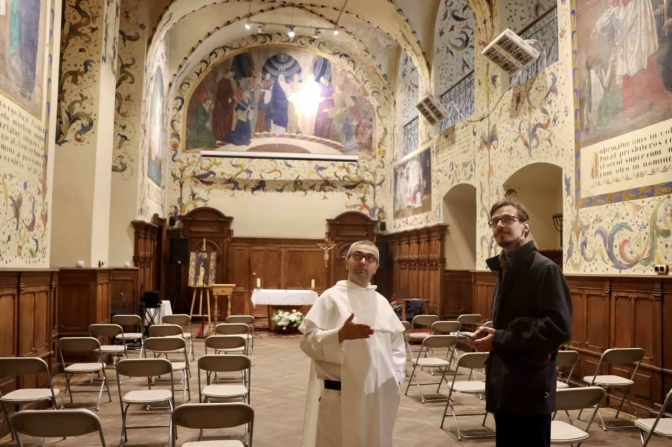
Father Ihor says that the leadership of the Roman Catholic Church has repeatedly asked the state to hand over the premises, but the process is moving very slowly.
This is the property of the state enterprise «Systema». There is a caretaker on the territory, there is a parking lot on the side of Kryvonosa Street. All the buildings are empty. There are only a few private consultations here. When the bishop asks to return these premises to the Roman Catholic Church, the state authorities say that everything is occupied here,» – the father-doctor says.
Time is not in favor of an architectural monument. Birches and poplars in the courtyard, which are visible to the naked eye, better than the conclusions of experts suggest that the complex needs urgent repairs. Painting is also under threat. Father Ihor says that Rosen’s frescoes may also suffer due to the dampness of the walls.

Fresco of the Descent of the Holy Spirit. On the right, there is a visible damage to the work – the result of the flow of water from the ceiling
«It’s a disaster. It all collapses, stands empty and distracted. In another courtyard, where there used to be a well, now after the rains there is some water on the ankle. The frescoes in the chapel itself are quite high, but they can be damaged there as well,» – the abbot of the chapel claims.
Read also: The fate of a monastery, later a secret police torture chamber and bus factory
If you go into the chapel, you can see that two frescoes are really damaged. The one depicting the Eucharist, in a miserable state, the central one – the Descent of the Holy Spirit – was partially destroyed. This is because of the water that poured straight from the ceiling through the holes in the roof. After this part was handed over to the Roman Catholic Church, the roof was repaired and the frescoes were preserved.
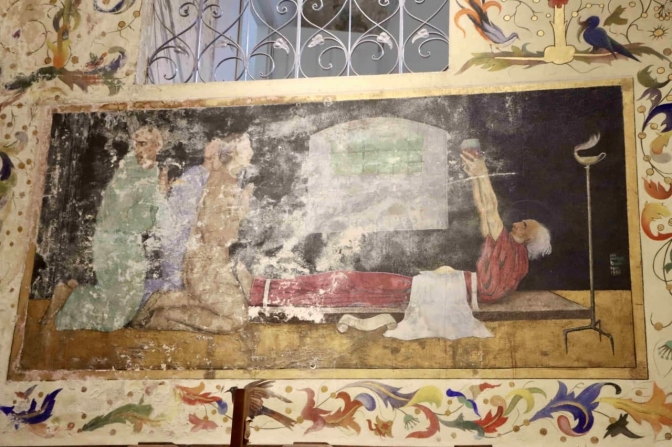
Fresco of the Eucharist. Significant traces of damage to work can be seen
Father Ihor says that the monastery was once turned into a seminary and seminarians lived in the cells. In the now empty complex, he shares the idea of creating a Catholic school or arranging something else for the benefit of Lviv residents.
«We can make a Catholic school here, or something else that serves the people of Lviv. Currently, there is only a shop and legal advice in this whole complex. The head of the state enterprise «Systema» says that all the premises are occupied. All these premises should have been handed over to the Church in 2001. Then, the decision was made during the visit of Pope John Paul II to Ukraine, who has already become a saint. However, then only the building of the Lviv archdiocese of the Roman Catholic Church was transferred to Vynnychenka Street, 32. The transfer of the monastery complex did not take place,» – the father-doctor says.
Not only the monastery complex is problematic, but also the Church of the Assumption. As you can read in the Lviv media, until 2018 there were joint services of Greek Catholics and Roman Catholics. In 2018, after the conflict, Greek Catholics changed the keys here. Lviv Metropolitan of the UGCC Ihor Vozniak recalled the only priest who served there, Fr. Yustinian Horodechnyi and ordered to give the church to the Roman Catholic community. 20 December, 2002, the church was transferred to the community as a collective property. Now, neither one nor the other serves the liturgy there, and Greek Catholic believers are going to listen to the liturgy on audio recording.
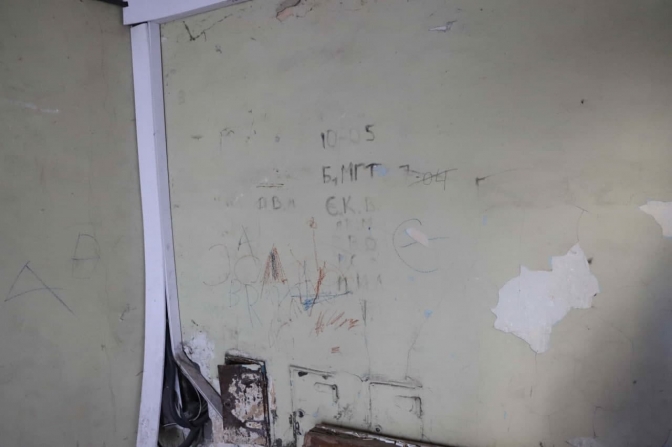
Vasyl Petryk, the head of the Department of cultural heritage protection in the Lviv Regional State Administration, also calls the monastery complex a unique architectural monument. He believes that this area needs revitalization and emphasizes that the possibility of access to the monument is very important.
«This is a unique monument in the city center. The whole complex of the monastery is a very interesting and valuable architectural monument of local significance. It is important for us, for citizens, city residents, and for the Ukrainian state that the monument be used for public function and be open to access. The territory needs revitalization. It is difficult to say what the state plans to do with the huge complex. Part of the premises, about 30%, was recently handed over to the Curia of the Lviv Archdiocese of the Roman Catholic Church. The rest continues to be state-owned by «Systema» Research Institute, which is subordinated to the Ministry of Economy. It is responsible for the preservation of the monument,» – Vasyl Petryk explains.
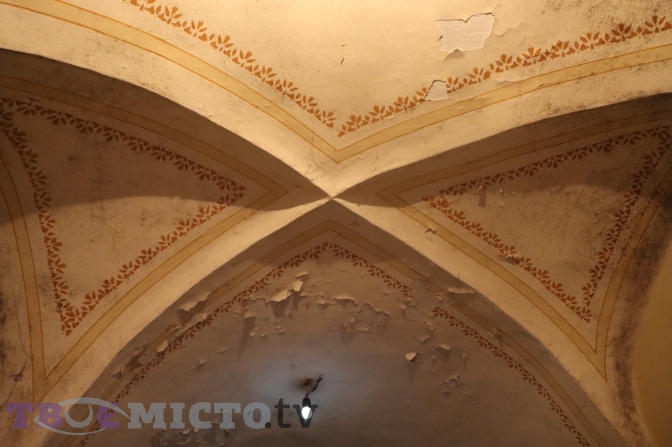
According to him, it is necessary to create a working group and also consult with the public. The working groups should hold meetings and present a vision of what will be done with these premises and how they will be used.
The last restoration of the cultural monument was carried out more than 50 years ago, Vasyl Petryk says. During this time, the central object of the complex – the Church of the Assumption – has reached a state of emergency.
«During the Soviet era, restoration was carried out there in the 70s and 80s. Some of the works and interiors have been preserved. Now, the tenants of those premises were various private companies. The central object of this complex – the Church of the Assumption – is owned by the Greek Catholic community. The temple is in a rather unsatisfactory condition, the roof is in an emergency condition and anti-emergency work needs to be carried out. As a representative of the regional administration, I support them. The project for emergency work on the monument is currently being approved by the Ministry of Culture. We hope that after the agreement, some funds will be allocated for this unique monument,» – Vasyl Petryk says.
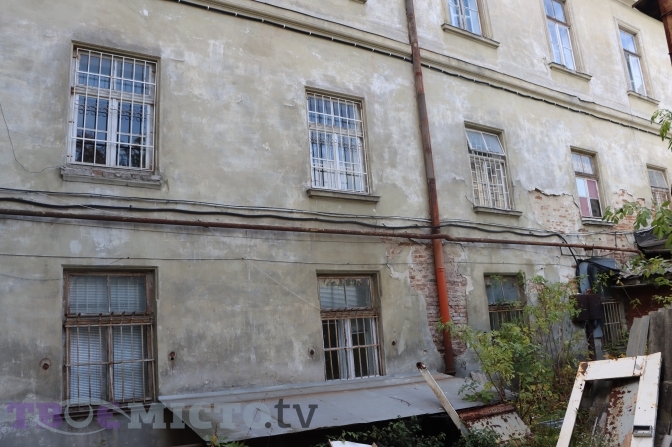
According to him, there are many ideas on how to use the monastery premises. Vasyl Petryk cites the Metropolitan Andrei Sheptytsky Museum (that has two buildings on Svobody Avenue and Drahomanova street) as an example of cooperation between the state and the public and believes that a research and art center or something similar could be built on Vynnychenka Street 30a.
«There are a lot of ideas for this area. It is important that this area is open, because any cultural heritage site should be open and accessible. We have a need and initiative to create an archeological museum, which would be very useful for the Lviv region, we have huge collections of archeological funds, which we have nowhere to store, we need a room for a monumental archive, where monuments could be stored, photo libraries. We have huge archives that need to be processed. There is no institution that would keep all this. There is no public center where such meetings and presentations take place. The nearest such center is the museum of Metropolitan Andrei Sheptytsky. This is a very good start. I think that on the example of such cooperation it would be possible to build a whole scientific and artistic center here,» – Vasyl Petryk summed up.
During the week, the editorial staff of Lviv Now tried to contact the management of the state enterprise «Systema», but was unable to talk to the head. We have sent a written request to the company and when we receive a response, we will publish the position of the enterprise.
Roman Tyshchenko-Lamanskyi, photo by Anna Chistyakova
Translated by Vitalii Holich
Follow us on Facebook and Instagram. Lviv Now is an English-language website for Lviv, Ukraine’s «tech-friendly cultural hub.» It is produced by Tvoe Misto («Your City») media-hub, which also hosts regular problem-solving public forums to benefit the city and its people.












